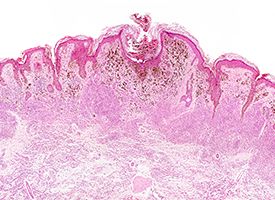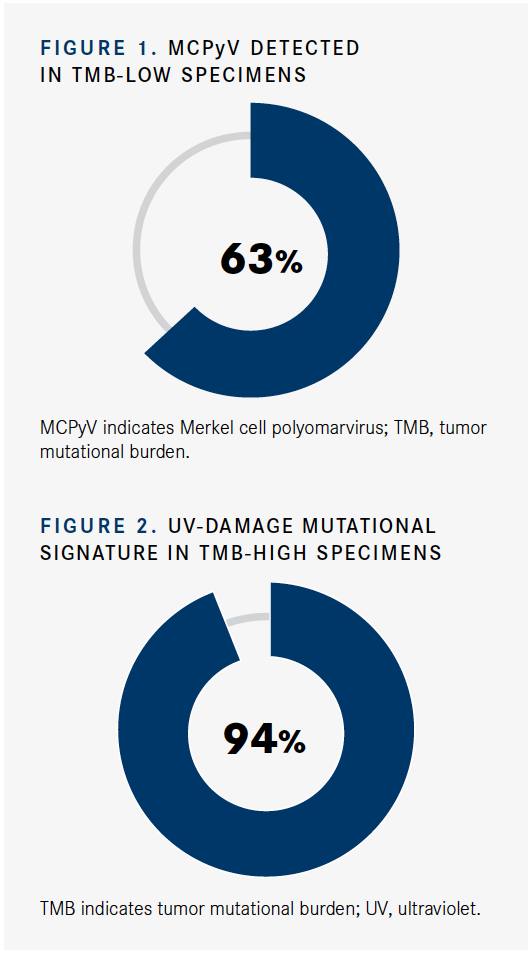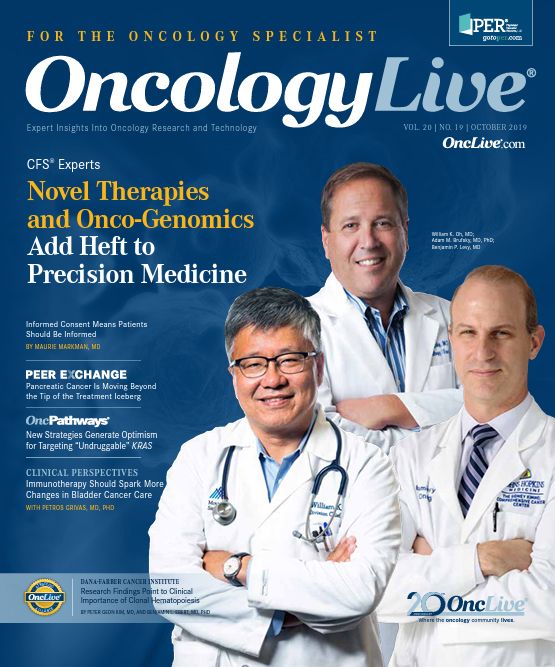Merkel Cell Carcinoma Study Matches TMB With Disease Drivers
The molecular profile of Merkel cell carcinoma differs depending upon whether the malignancy is driven by ultraviolet light or by a virus and can be correlated with responses to immunotherapy, according to recent study findings.

The molecular profile of Merkel cell carcinoma (MCC) differs depending upon whether the malignancy is driven by ultraviolet (UV) light or by a virus and can be correlated with responses to immunotherapy, according to recent study findings.
Investigators from the H. Lee Moffitt Cancer Center and Research Institute analyzed tumor mutational burden (TMB) and other response biomarkers in what they said is the largest genomic study to date in MCC.
“These results provide a comprehensive genomic characterization of MCC, show a novel means of detecting MCPyV [Merkel cell polyomavirus] using targeted sequencing, place molecular subgroups in the context of other human cancers, and demonstrate the importance of using immunotherapy as early as possible,” the investigators wrote in their study, which was recently published in Clinical Cancer Research.
In the study, 317 tumors from patients with MCC underwent comprehensive genomic profiling by Foundation Medicine between May 2013 and April 2018. The samples were profiled for 322 cancer-related genes and evaluated for TMB and mutational signatures. The presence of MCPyV was also detected through DNA sequencing.
Click to Enlarge

In the clinical cohort, the most common diagnosis was stage IIIB or IV MCC (78.9%). Almost half of the immunotherapy-treated patients (47%) received immune checkpoint inhibition with pembrolizumab (Keytruda) monotherapy, and 26% received avelumab (Bavencio) monotherapy. Radiation therapy was given prior to immunotherapy for 79% of patients, and 16% of patients did not receive any radiation. Most patients were treated with immunotherapy in the first-line (32%) or second-line (40%) setting; 2 patients were treated in the fifth-line setting.
Outcomes of Genomic Profiling of Tumor Samples
Genomic testing revealed that there was a bimodal distribution based on TMB in the MCC samples; specimens were mostly either TMB-low (n = 175; 55%), which was defined as <6 mutations per megabase, or TMB-high (n = 117, 37%), defined as ≥20 mutations/ megabase. Twenty-five samples (8%) had intermediate TMB. This trend was echoed in the clinical cohort as well, with 56% of patients characterized as TMB-low and 39% as TMB-high.
In the TMB-high group, short variant mutations were noted in either TP53 or RB1, or both genes. The most commonly altered genes in the TMB-high group were TP53 (97%), RB1 (80%), and the NOTCH family of genes (50%). In the TMB-low group, no genomic alterations were found that were likely to be oncogenic drivers, with the most commonly altered genes being TP53 (13%), RB1 (9%), and PTEN (7%).
Copy number alterations were noted infrequently, amounting to 24% of the TMB-high specimens, with copy number gains found in the MYCL and MYC genes and deletions found in RB1, PTEN, TP53, LRP1B, CDKN2A, and NF1.
MCPyV genomic DNA was detected in 36% of the overall samples by next-generation sequencing (NGS) and in 37% of the clinical cohort and was strongly associated with TMB classification. MCPyV DNA was observed in 63% of the TMB-low specimens (Figure 1) but not in any of the TMB-high cases (P ≤.00001).
On the other hand, the UV-damage mutational signature was correlated with a high TMB classification, with 94% of the TMB-high samples expressing a UV signature (Figure 2). This signature was found to be mutually exclusive with MCPyV integration.
In the TMB-intermediate group, 36% had a UV signature and 16% were classified as viral-positive by NGS, and 44% could not be classified with either of the 2 molecular subgroups.
A clustering analysis of the top 10 most commonly altered genes in a variety of cancer types demonstrated that TMB-high MCC was most similar to neuroendocrine tumors such as prostate neuroendocrine carcinoma, bladder neuroendocrine carcinoma, and small cell lung cancer.
TMB-low MCC, conversely, was most similar to carcinoid tumors and virally driven cancers such as human papillomavirus—positive head and neck squamous cell carcinoma (SCC), cervical SCC, anal SCC, and Kaposi sarcoma.
Outcomes in the Clinical Cohort
Thirty-six of the patients in the clinical cohort who were treated with immune checkpoint inhibition were evaluable for response at the time of the analysis. The overall response rate (ORR) was 44%, consisting of 5 complete responses and 11 partial responses. At a median follow-up of 16.9 months (range, 14.0-27.3) from the time of diagnosis of advanced or metastatic disease, all 16 responding patients were still alive compared with 4 patients who did not respond favorably (P <.0001).
Among the evaluable patients, 14 were categorized as having the UV signature and being TMB-high and the other 22 as viral-positive and TMB-low. The ORR was 50% in the UV signature group compared with 41% in the MCPyV-positive group (P = .63).
The response rates changed more significantly according to the line of therapy in which patients received immune checkpoint inhibition. Patients treated in the first-line setting (n = 12) had an ORR of 75%, those treated in the second line (n = 13) had an ORR of 39%, and those treated in the third line or later (n = 11) had an ORR of 18% (P = .0066). This analysis only counted the first immune checkpoint inhibitor received, as several patients received more than 1 in the course of their treatment. Line of therapy was statistically significantly associated with treatment response by multivariate analysis (P <.01).
The study authors noted that “while both subsets respond similarly well to immunotherapy, clinical response is associated with a long-term impact on survival. Importantly, the use of other therapies prior to immunotherapy negatively influences the ultimate response to immunotherapy, suggesting that immune checkpoint blockade should be used initially when possible.”
Knepper TC, Montesion M, Russell JS, et al. The genomic landscape of Merkel cell carcinoma and clinicogenomic biomarkers of response to immune checkpoint inhibitor therapy [published online August 9, 2019]. Clin Cancer Res. doi: 10.1158/1078-0432.CCR-18-4159.
Additionally, 57 of the patients with advanced or metastatic MCC who were treated at Moffitt were analyzed in the clinical cohort, and 38 received an immune checkpoint inhibitor.




